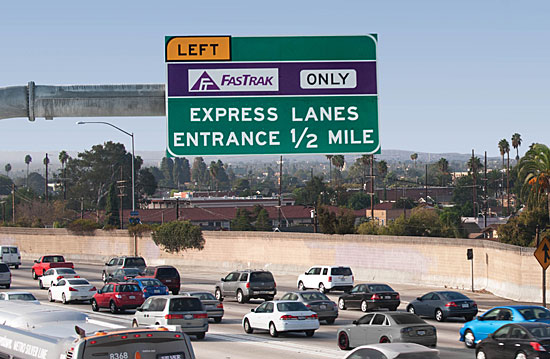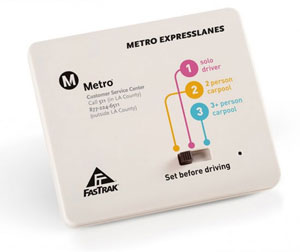Life in the ExpressLanes
November 1, 2012

The ExpressLanes project promises, at least temporarily, to change commuting as we know it on the 110.
In the city known for its freeways, things are about to get a little less free. Toll lanes are coming to the 110 Freeway starting November 10, when Metro’s new ExpressLanes pilot program shifts into gear, dramatically changing the way motorists operate on a major roadway south of downtown Los Angeles.
The program is aimed at reducing congestion on the 110, a major route for commuters who work, live or pass through downtown. For the first time, solo drivers will—for a price—be able to travel in what were once lanes dedicated solely to carpoolers.
“Status quo isn’t working, and that’s the reality,” said Stephanie Wiggins, the project manager. “Traffic is at such crisis proportions that we need to make a change.”
But Wiggins acknowledges that the logistics may be confusing, at least initially, in an L.A. motoring culture that for generations has cherished the “free” in its freeway system.
So buckle up your seatbelts and pay attention. Here’s what you need to know.
Everybody who wants to use the express lanes needs to get a transponder for their vehicle and establish an account, with an initial deposit of $40. Everyone also will pay a $3 monthly maintenance fee, in addition to fares charged for driving in the lanes, which will vary depending on how heavy the traffic is. The more congested, the higher the price per mile. Fees range from 25-cents to $1.40 per mile.
Real-time pricing will be displayed on electronic signs along the freeway, and sensors will communicate with on-board transponders to deduct fares automatically from the pre-paid account.
Now—stay with us—here’s some of the fine print.
Carpoolers and motorcyclists will still be able to use the lanes without paying fares. But to do so, they’ll need to open an account and get a transponder, which costs money. (Applicants can, however, apply for an income-based “equity plan,” which reduces the initial deposit to $15 and waives the monthly fee for those who qualify.)
The system is based on the transponders’ ability to read how many people are traveling in a vehicle. So drivers will have to set the switch on their transponders to 1, 2 or 3—indicating how many people are onboard. If it’s set to “1,” the fares for solo drivers will be triggered; otherwise, it’s a free ride for carpoolers.
Drivers can sign up on the program’s website, at Metro customer service walk-in centers or by calling 511. It can also be done at local Automobile Club branches, where full accounts will be offered at a 20% discount.
The transponder will work on FasTrak toll roads across California, including those already operating in Orange, Riverside and San Diego counties. In Los Angeles County, the lanes will start on the 110 between downtown and the Harbor Gateway Transit Center, near the 91 Freeway in the Carson area. Come January or February of next year, they’ll also open on the 10 east of downtown. See this map for more detail on the L.A. County lanes.)
Law enforcement and cameras will make sure everyone is paying the proper fares. California Highway Patrol will issue $341 citations to FasTrak users who have set their transponders to indicate the wrong number of riders. Camera enforcement will be used for those without transponders, with violators receiving fines equal to the toll they would have paid plus a $25 penalty.
The pilot program is being funded by a $210 million grant from the United States Department of Transportation. The grant underwrites the program, road improvements and increased bus service in the corridor, using 59 new clean fuel buses. To encourage more people to try the bus instead of driving, Metro is waiving monthly account fees for registered TAP card users who make four one-way trips along the corridor.
As is probably evident by now, there are a lot of moving parts to the express lanes project. Yet Wiggins remains optimistic, citing the success of similar programs in other parts of California and nationwide.
“All the other cities have experienced a ramp-up,” said Wiggins. “There is a period where the customer takes time to adopt it.”
Metro is partnering on the project with Caltrans, and has contracted with FasTrak, a private company, to produce the transponders. After the one-year pilot period has ended, collected data will be analyzed and presented to the state legislature. Then, Metro’s Board of Directors will decide whether to continue the program or scrap it.
Posted 11/1/12













 405 bridge work causes a stink
405 bridge work causes a stink

